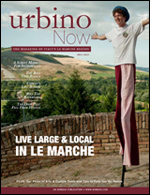In the Le Marche region, tucked in the hills and mountains between Tuscany and the Adriatic, lies Urbino. It is not a commonly known city, but it was one of the most influential during the Renaissance, thanks to Frederico da Montefeltro, nicknamed “The Light of Italy.” Beginning his career as one of the most successful condottieri, or mercenary leaders, of the time, Frederico eventually turned his success from war to peace and enlightenment. He ruled Urbino from 1444 to his death in 1482 by promoting humanist principles, as well as creating one of the largest libraries outside of the Vatican through his scriptorium. He was also a patron of the fine arts, laying the foundation for the development of artists such as Giovanni Santi and later, after Frederico’s death, Raphael Santi. Frederico’s contributions to the Renaissance helped propel Italian art to become the most influential of the period.
Luca Catani, 37, a professor of information technology at the University of Urbino, is currently helping to change the face of art in Italy through his website Artevista.
“Artevista is a network where I try to promote cultural events, museums, artists, especially here in Italy,” says Catani, who started the website four years ago.
Many artists, including students as well as professors in Urbino, use the website to network and get their artwork out in the open.
“Urbino being such a small place, being out of the mainstream of things, this is a way for people to know more about it,” says the director of the Academy, Sebastiano Guerrera. “It’s not easy to get over those limits that are geographical. Italy is separated by mountains and a lot of places are isolated and out of the mainstream. Being that Artevista focuses on local artists, it opens them to the world.”
Users can search for museums, galleries, and individual artist profiles by geographical region. Those artists can upload profiles as well as examples of their work.
But Artevista isn’t limited to Urbino. Its artists and those interested in their works come from all over Italy and have begun to expand further.
“A few months ago I started to promote also some exhibitions from Spain and England,” Catani says.
Artevista’s biggest roadblock is Italy’s own government. Led by Prime Minister Silvio Berlusconi and Finance Minister Giulio Tremonti, Italy has instituted numerous budget cuts from its cultural support over the past few years. “You can’t eat culture,” Tremonti was quoted as saying. The cuts, and this comment, have upset many and hampered artistic growth and education.
“The money that’s allotted for [art] materials doesn’t exist anymore. So each student is responsible for buying everything, anything,” says Marie Calajoe, an American who came to Urbino in 1985 to work with art conservation and restoration and currently teaches technical language at the Academy di Belle Arti and the University of Urbino. “You can’t get a [public] loan like you can in the states. There used to be grants and scholarships that were really limited. There are almost no grants anymore. That makes it very difficult.”
“I think the main problem is that here in Italy it’s really hard to find money for culture,” says Catani, who is forced to rely on donations to keep his Artevista project running. “I try to help artists from Urbino to be famous. And it’s necessary that someone help Artevista to do it.”
